Published
- 17 min read
Top 10 IaaS Cloud Providers Compared in 2025
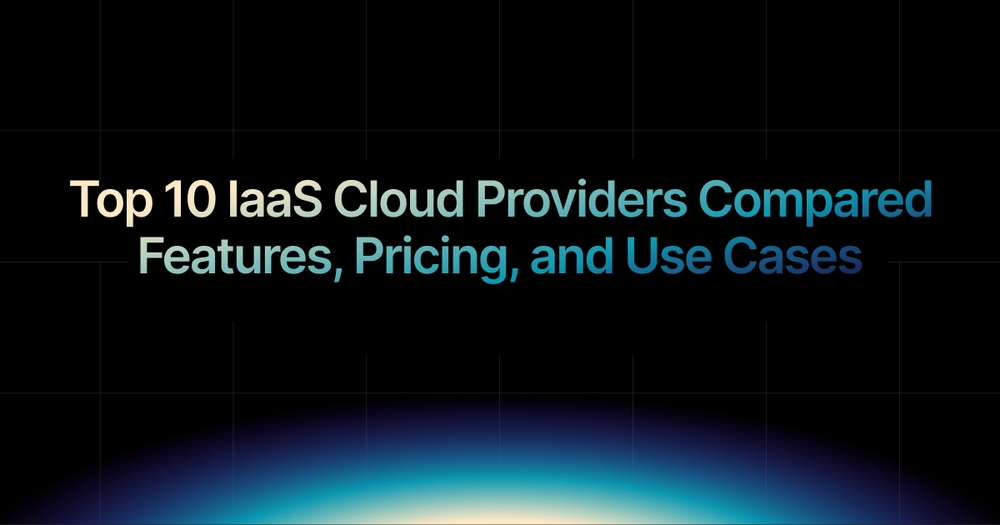
Introduction
Infrastructure as a Service (IaaS) is the foundation of modern cloud computing. Whether you are a startup deploying your first application or an enterprise managing large clusters, your choice of infrastructure directly affects performance, scalability, and cost.
In 2025, developers and businesses are not just comparing prices anymore. They are searching for simplicity, automation, and control. Platforms like Kuberns combine all of these by integrating AI-powered deployment automation with AWS-backed infrastructure.
This guide compares the top 10 IaaS cloud providers in 2025 based on features, pricing, and use cases, and explains why Kuberns is fast becoming the preferred choice for cost-efficient and stress-free cloud deployment.
What Is IaaS and Why It Matters
Infrastructure as a Service (IaaS) provides virtualised compute, storage, and networking resources on demand. Instead of maintaining physical servers, you can rent what you need and pay for actual usage.
When combined with intelligent automation through Kuberns, IaaS becomes easier to manage and more affordable. Kuberns automates provisioning, scaling, and monitoring, removing the repetitive DevOps work that slows teams down.
Key Benefits of IaaS
- Elastic scaling: Adjust infrastructure instantly based on demand.
- Transparent pricing: Pay only for what you use with clear cost visibility.
- Global reach: Deploy closer to your users for better performance.
- Security: Built-in encryption and IAM for data protection.
- Automation: Tools like Kuberns bring AI-based scaling and monitoring on top of IaaS providers.
If you want to learn how deployment automation fits into this model, read What Is Automated Deployment and How It Works.
Why Choosing the Right IaaS Provider Matters
The right IaaS provider defines how well your application scales and how much you spend each month. Each provider has a different pricing approach, level of automation, and Kubernetes support.
Consider these factors when choosing your platform:
- Latency and region availability
- Pricing model and hidden costs
- Auto-scaling and container support
- Ecosystem integrations
- Ease of deployment and management
If you are already managing Kubernetes clusters, you can explore How to Eliminate Manual Steps in Your CI/CD Workflow to see how Kuberns simplifies the process.
Top 10 IaaS Cloud Providers in 2025
Here’s a detailed look at the most trusted IaaS providers and how they compare across features, pricing, and ideal use cases.
| # | Provider | Key Features | Pricing Overview | Best Use Cases |
|---|---|---|---|---|
| 1 | Kuberns | AI-powered PaaS built on AWS infrastructure, automates deployment, scaling, and monitoring, offers up to 40% AWS cost savings. | Transparent AWS-based pricing, no platform fees, zero per-user charges. | Startups, developers, and teams wanting one-click deployment with full control and low costs. |
| 2 | Amazon Web Services (AWS) | Most mature ecosystem, extensive regional coverage, powerful Kubernetes support with EKS. | On-demand, reserved, and spot pricing options. | Global enterprise applications and production Kubernetes clusters. |
| 3 | Microsoft Azure | Strong enterprise support, integrates with Windows Server, Active Directory, and Azure Stack. | Pay-as-you-go, reserved VMs, hybrid discounts. | Enterprises using Microsoft environments or hybrid setups. |
| 4 | Google Cloud Platform (GCP) | Industry leader in Kubernetes with GKE, advanced AI and ML services. | Sustained-use discounts and per-second billing. | Data-driven applications, AI workloads, and containerized systems. |
| 5 | Alibaba Cloud | Fast-growing cloud in Asia, local compliance, and low latency. | On-demand and subscription-based pricing. | APAC-focused businesses and multi-region e-commerce. |
| 6 | Oracle Cloud Infrastructure (OCI) | Predictable pricing, strong enterprise focus, high-performance compute. | “Always Free” tier and bring-your-own-license options. | Database-intensive and ERP-based workloads. |
| 7 | IBM Cloud | Focused on hybrid and multi-cloud environments, OpenShift integration. | Monthly and hourly billing with SLAs. | Regulated industries such as finance and telecom. |
| 8 | DigitalOcean | Simple and transparent pricing, easy for developers to use. | Flat monthly rates, few hidden costs. | Startups and small business applications. |
| 9 | Linode (Akamai) | Developer-friendly, straightforward compute and storage. | Fixed pricing with bandwidth included. | Smaller workloads and regional hosting. |
| 10 | Kamatera | Fully customizable VMs, flexible resource scaling. | Hourly billing, full configurability. | Test environments and variable workloads. |
Deep Dive: Leading IaaS Platforms
1. Kuberns
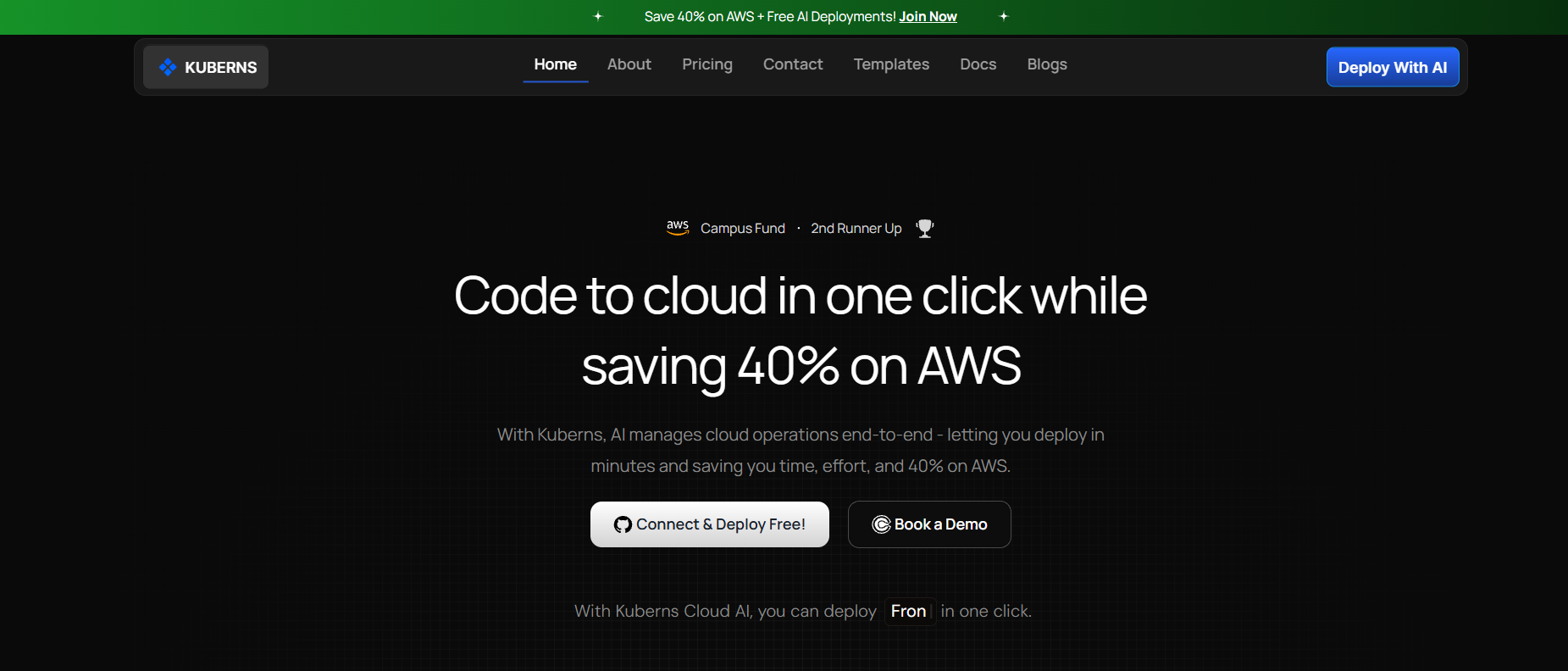 Kuberns combines the reliability of AWS infrastructure with intelligent automation to simplify deployment, scaling, and monitoring. It brings IaaS and PaaS together in one place, eliminating the need for complex DevOps management.
Kuberns combines the reliability of AWS infrastructure with intelligent automation to simplify deployment, scaling, and monitoring. It brings IaaS and PaaS together in one place, eliminating the need for complex DevOps management.
- Infrastructure foundation: Built on top of AWS for global reach and high availability.
- AI automation: Automatically scales resources based on real-time traffic and performance metrics.
- Developer experience: One-click deployment for any stack, including Node.js, Django, Flask, and React.
- Monitoring and alerts: Integrated dashboards for performance tracking, logs, and uptime insights.
- Cost optimization: Intelligent resource allocation helps reduce AWS costs by up to 40%.
Learn more in What Is Kuberns: A Simpler Way to Build, Deploy, and Scale Apps.
2. Amazon Web Services (AWS)
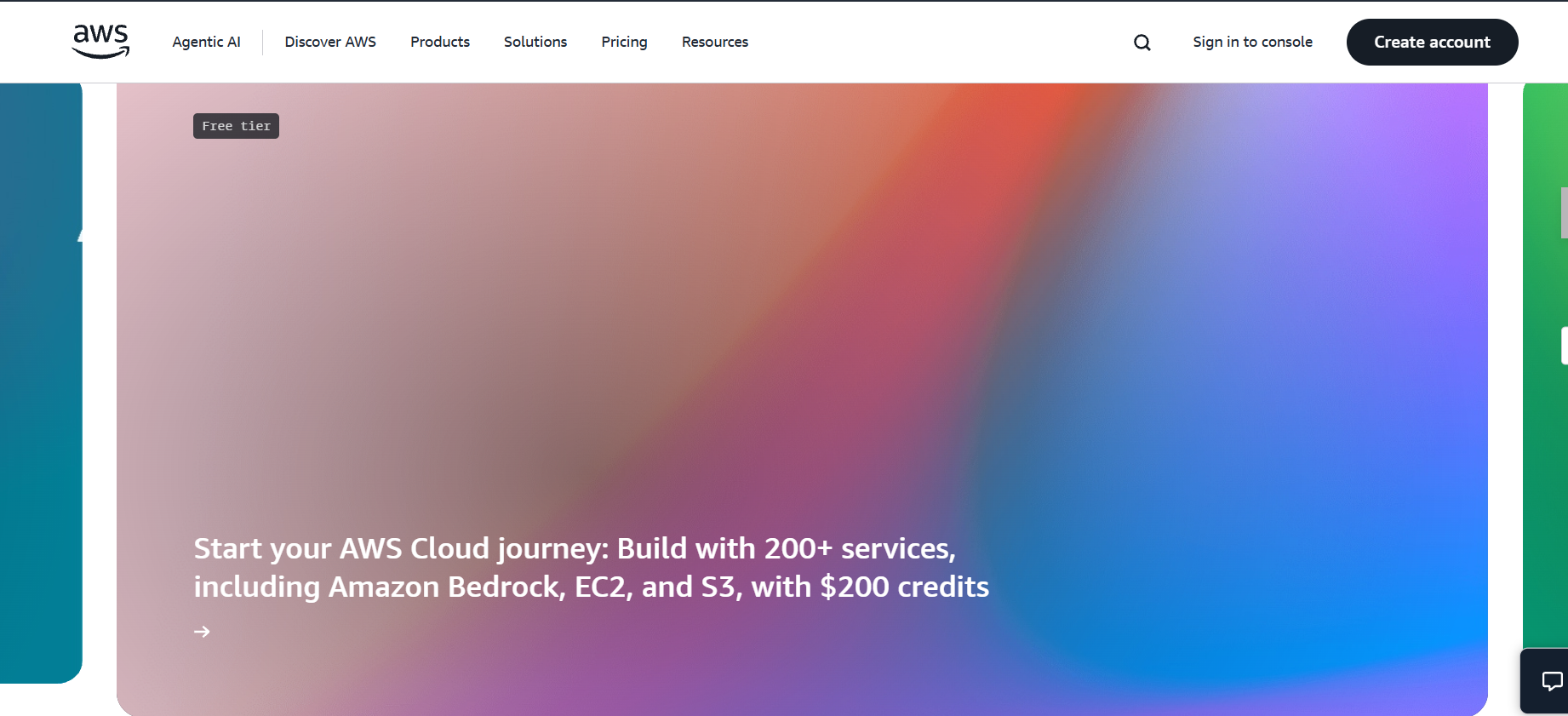 AWS remains the most mature IaaS platform with the largest portfolio of services, covering compute, storage, networking, analytics, and machine learning. Its global infrastructure spans multiple availability zones in every major region.
AWS remains the most mature IaaS platform with the largest portfolio of services, covering compute, storage, networking, analytics, and machine learning. Its global infrastructure spans multiple availability zones in every major region.
- Compute and networking: EC2, Auto Scaling, Elastic Load Balancing, and VPCs provide flexibility at scale.
- Kubernetes integration: Amazon Elastic Kubernetes Service (EKS) delivers managed container orchestration.
- Storage options: Includes S3 for object storage, EBS for block volumes, and Glacier for archival data.
- Pricing model: Mix of on-demand, reserved, and spot instances for flexible cost management.
- Best for: Enterprises that need scalability, reliability, and integration across multiple services.
If you are exploring more affordable alternatives to AWS, read Best AWS Alternatives for Cheaper Cloud Hosting for a detailed comparison and cost insights.
3. Microsoft Azure
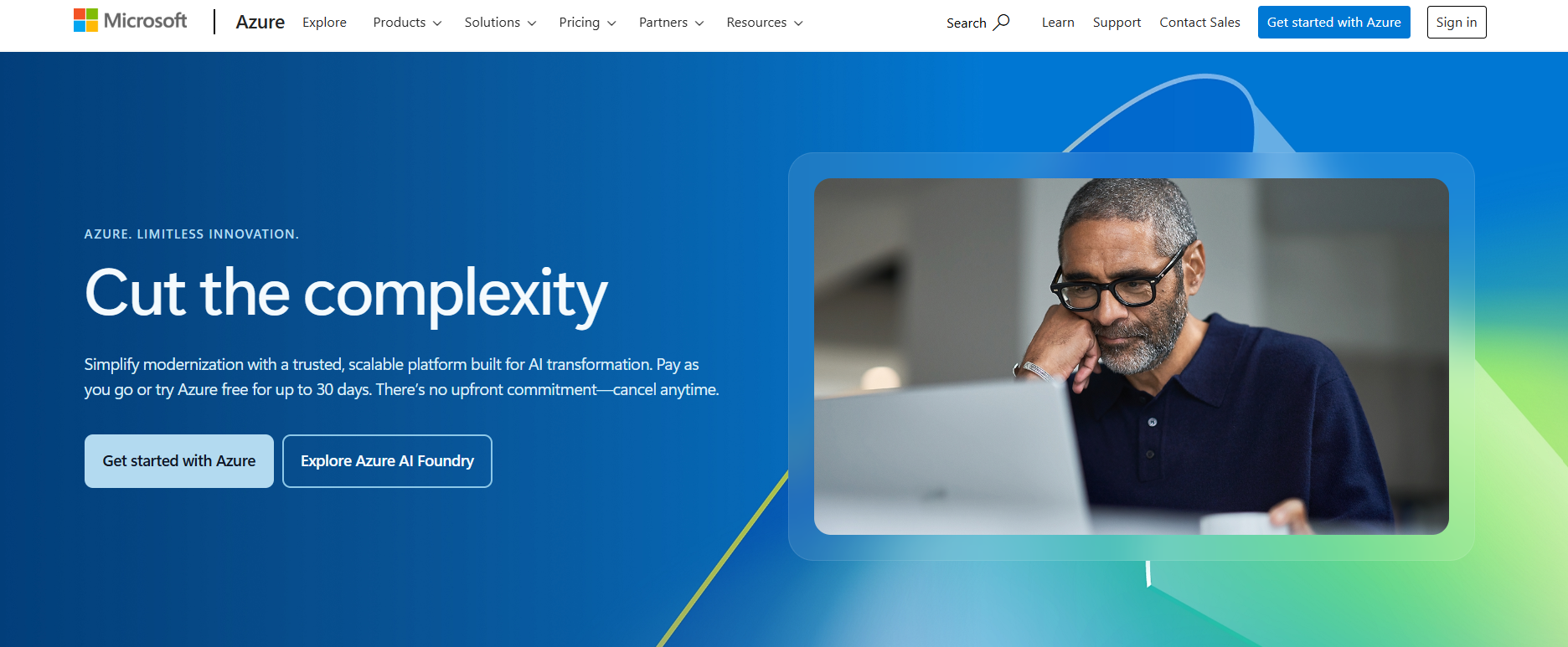 Microsoft Azure offers a strong hybrid and enterprise-focused cloud ecosystem. It’s tightly integrated with Windows Server, Active Directory, and Microsoft’s suite of productivity tools.
Microsoft Azure offers a strong hybrid and enterprise-focused cloud ecosystem. It’s tightly integrated with Windows Server, Active Directory, and Microsoft’s suite of productivity tools.
- Hybrid capabilities: Azure Arc and Azure Stack allow consistent operations between on-prem and cloud.
- Kubernetes and DevOps: Azure Kubernetes Service (AKS) integrates with Azure DevOps and GitHub Actions for CI/CD automation.
- Security: Enterprise-grade compliance, identity management, and zero-trust network policies.
- Pricing flexibility: Discounts through reserved instances and hybrid benefits for existing licenses.
- Best for: Enterprises already invested in the Microsoft ecosystem or hybrid cloud environments.
For businesses evaluating different cloud platforms, check out Azure Alternatives to compare performance, pricing, and flexibility across modern providers.
4. Google Cloud Platform (GCP)
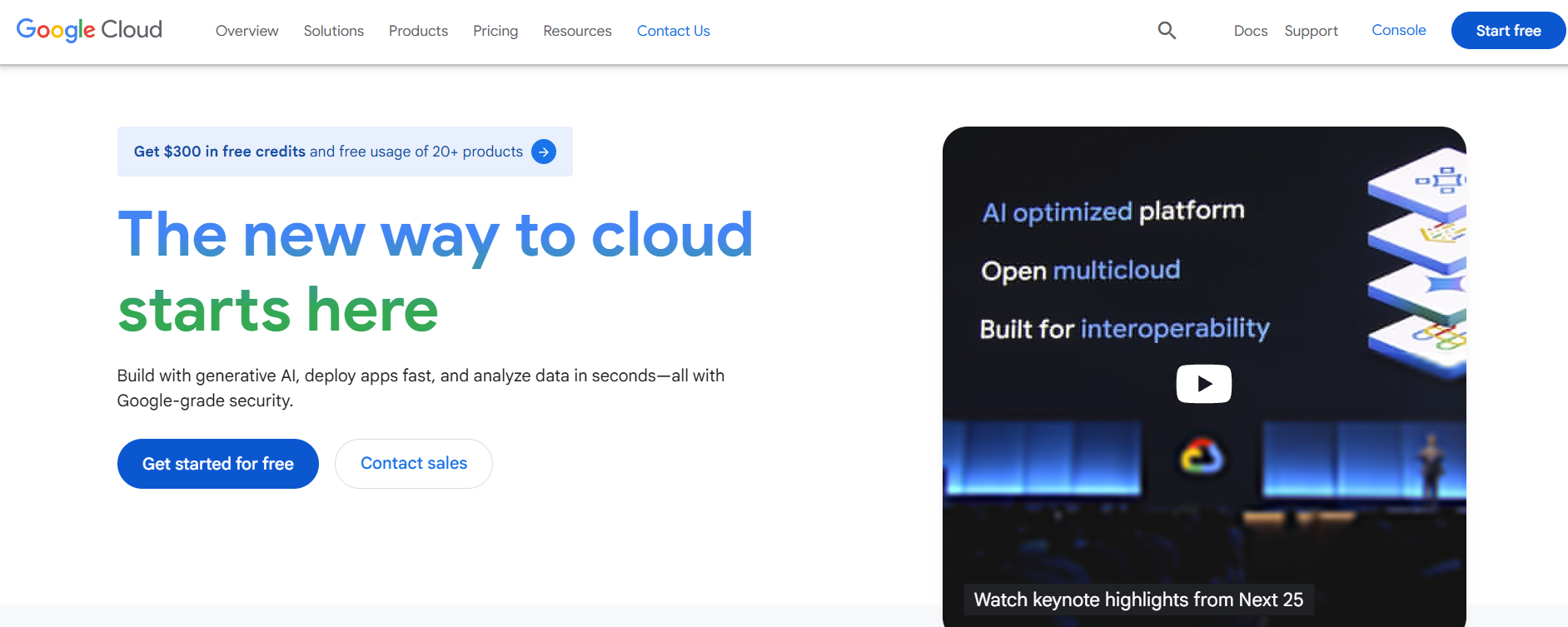 Google Cloud Platform (GCP) is widely recognised for innovation in data analytics, AI, and container orchestration. It offers one of the smoothest Kubernetes experiences through Google Kubernetes Engine (GKE).
Google Cloud Platform (GCP) is widely recognised for innovation in data analytics, AI, and container orchestration. It offers one of the smoothest Kubernetes experiences through Google Kubernetes Engine (GKE).
- Container-first design: GKE delivers automated node management, scaling, and self-healing clusters.
- Data and ML tools: BigQuery, Vertex AI, and Cloud Run simplify advanced analytics and ML workflows.
- Networking: Global private fiber network with edge caching for low-latency applications.
- Billing structure: Per-second billing, sustained-use discounts, and cost estimators for transparency.
- Best for: AI-driven startups, data-intensive workloads, and container-based SaaS applications.
If you are comparing cloud providers for performance and cost efficiency, explore Google Cloud Alternatives to see how different platforms, including Kuberns, can deliver more automation and better value.
5. Alibaba Cloud
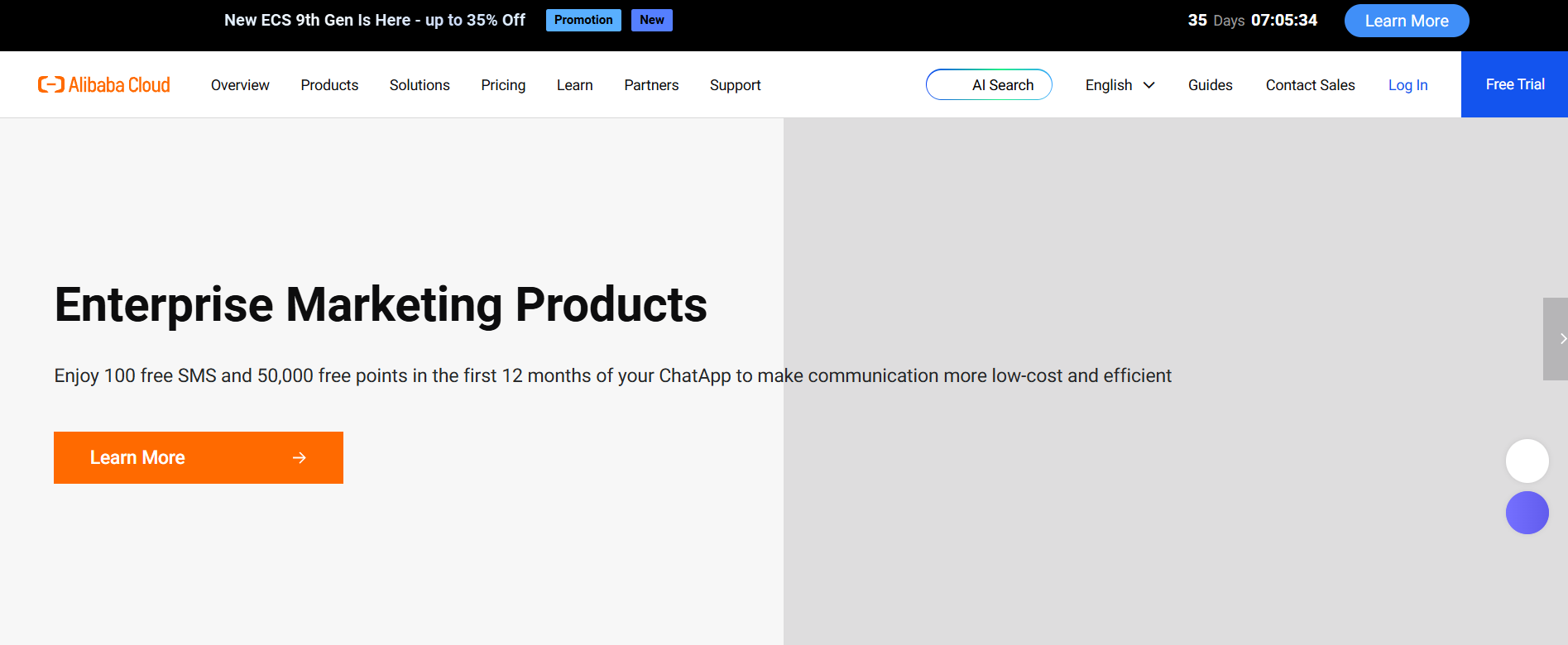 Alibaba Cloud is the leading cloud provider in Asia, with a strong presence across APAC, the Middle East, and Europe. It offers excellent local compliance, performance, and scalability for regional businesses.
Alibaba Cloud is the leading cloud provider in Asia, with a strong presence across APAC, the Middle East, and Europe. It offers excellent local compliance, performance, and scalability for regional businesses.
- Core services: Elastic Compute Service (ECS), Object Storage Service (OSS), and ApsaraDB for databases.
- Kubernetes integration: Alibaba Cloud Container Service (ACK) supports hybrid and multi-zone deployments.
- Regional advantage: Low latency and local compliance with China’s and ASEAN countries’ regulations.
- Security: Built-in DDoS protection and encryption for financial-grade workloads.
- Best for: Businesses with users in Asia-Pacific or companies expanding into Chinese markets.
To explore how regional cloud platforms compare globally, read Top Cloud Solutions for Businesses for a deeper look at performance, scalability, and cost options.
6. Oracle Cloud Infrastructure (OCI)
 Oracle Cloud Infrastructure (OCI) focuses on high-performance computing, enterprise workloads, and predictable pricing. Its network design offers minimal latency and consistent throughput.
Oracle Cloud Infrastructure (OCI) focuses on high-performance computing, enterprise workloads, and predictable pricing. Its network design offers minimal latency and consistent throughput.
- Compute performance: Bare metal servers and flexible VM shapes for high-demand applications.
- Database strength: Deep integration with Oracle Database and Autonomous Database services.
- Hybrid cloud options: Oracle Cloud@Customer allows on-prem deployments with full OCI control.
- Cost model: Transparent and predictable, with generous free tiers and bring-your-own-license options.
- Best for: Enterprises with heavy database or ERP workloads needing performance consistency.
7. IBM Cloud
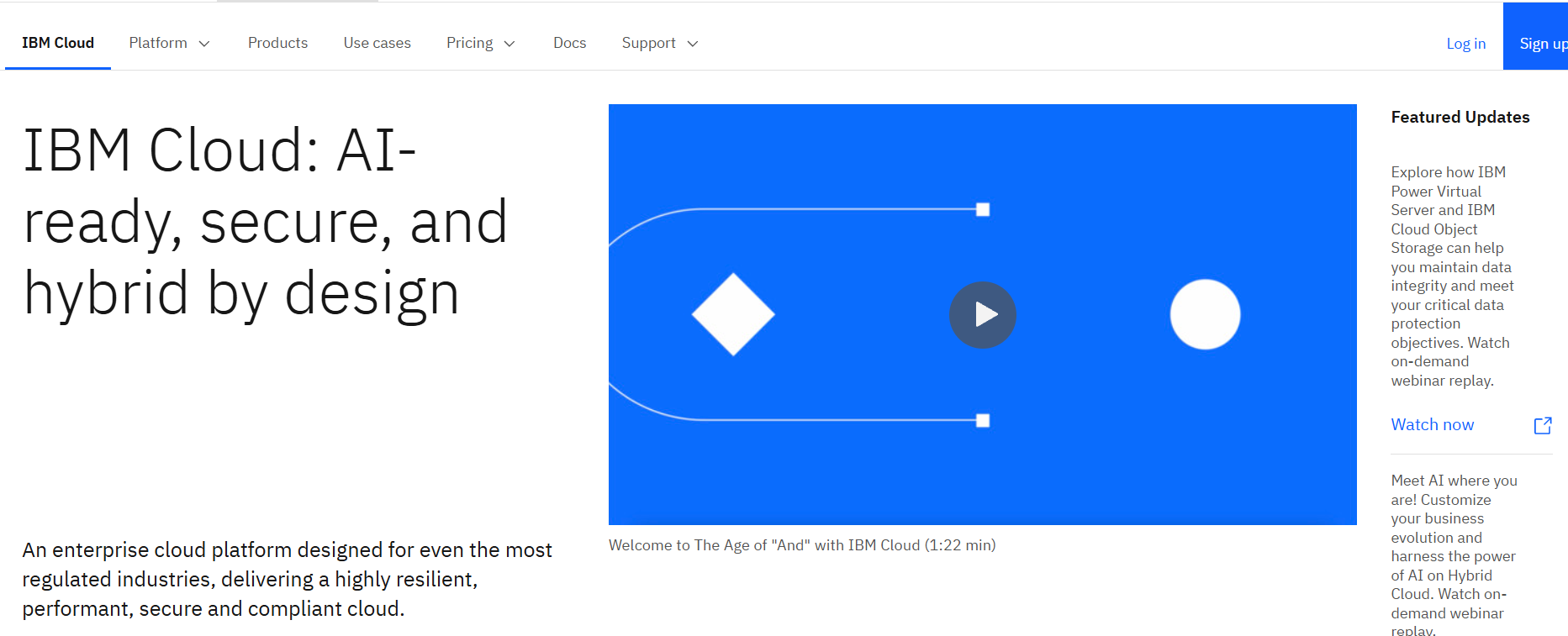 IBM Cloud is designed for hybrid, regulated, and enterprise-grade workloads. It blends traditional IT systems with modern cloud infrastructure through its OpenShift-based platform.
IBM Cloud is designed for hybrid, regulated, and enterprise-grade workloads. It blends traditional IT systems with modern cloud infrastructure through its OpenShift-based platform.
- Hybrid and multicloud: IBM Cloud Satellite supports consistent operations across environments.
- Kubernetes support: Managed OpenShift clusters for containerised applications.
- Compliance: Meets stringent industry regulations for finance, healthcare, and government.
- AI and analytics: Watson AI and Cloud Pak for Data offer advanced analytics integration.
- Best for: Enterprises needing strong governance, compliance, and hybrid architecture flexibility.
8. DigitalOcean
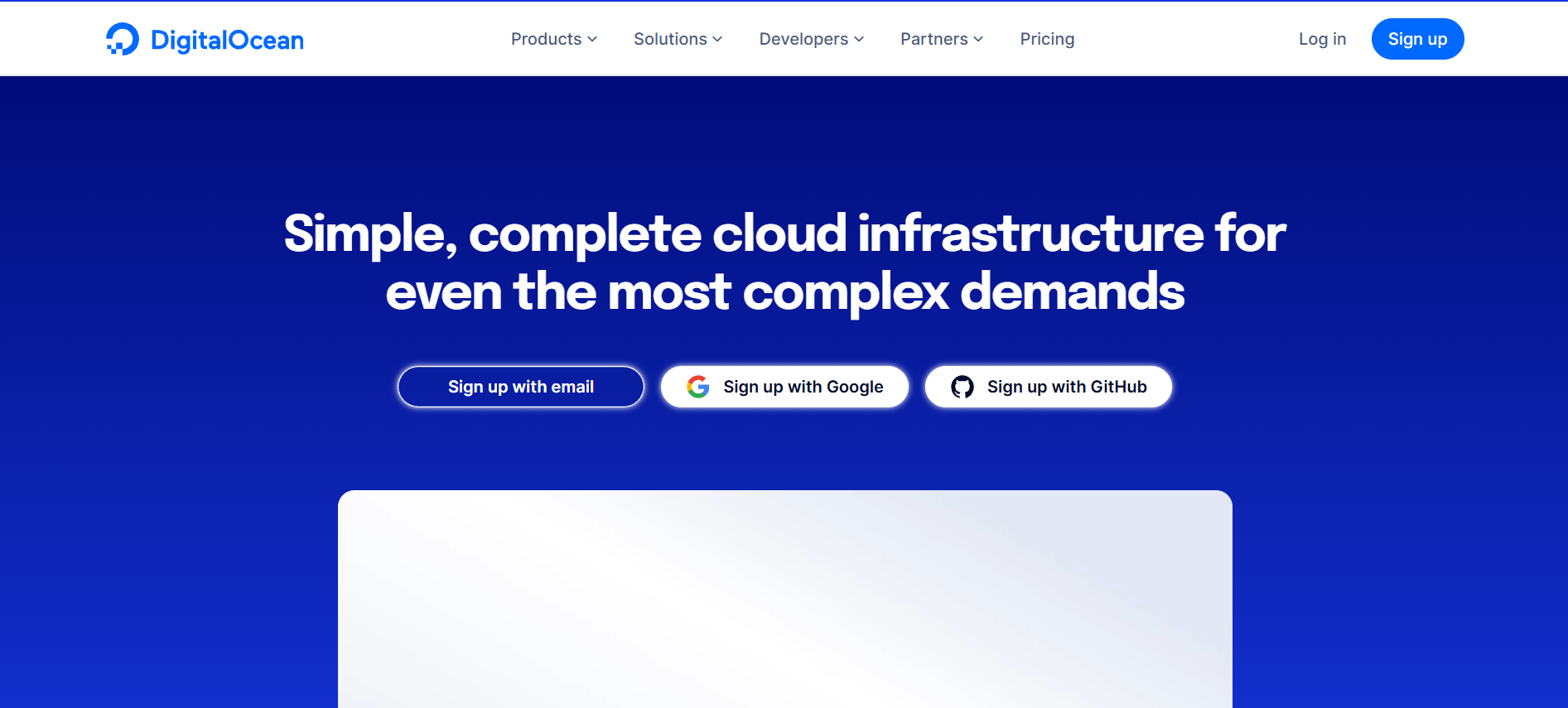 DigitalOcean is a developer-friendly cloud provider known for simplicity and transparent pricing. It is particularly popular among startups, freelancers, and small businesses.
DigitalOcean is a developer-friendly cloud provider known for simplicity and transparent pricing. It is particularly popular among startups, freelancers, and small businesses.
- Ease of use: Intuitive dashboard and API for developers.
- Compute offerings: Droplets (VMs), managed databases, and Kubernetes (DOKS).
- Pricing: Flat monthly rates, predictable costs, and no hidden charges.
- Community support: Extensive documentation and open developer community.
- Best for: Small teams, prototypes, and cost-conscious developers seeking simplicity.
If you are looking for a more automated and cost-efficient option, explore Best DigitalOcean Alternative for Startups and Solo Developers to see how platforms like Kuberns simplify deployment and reduce cloud expenses.
9. Linode (Akamai)
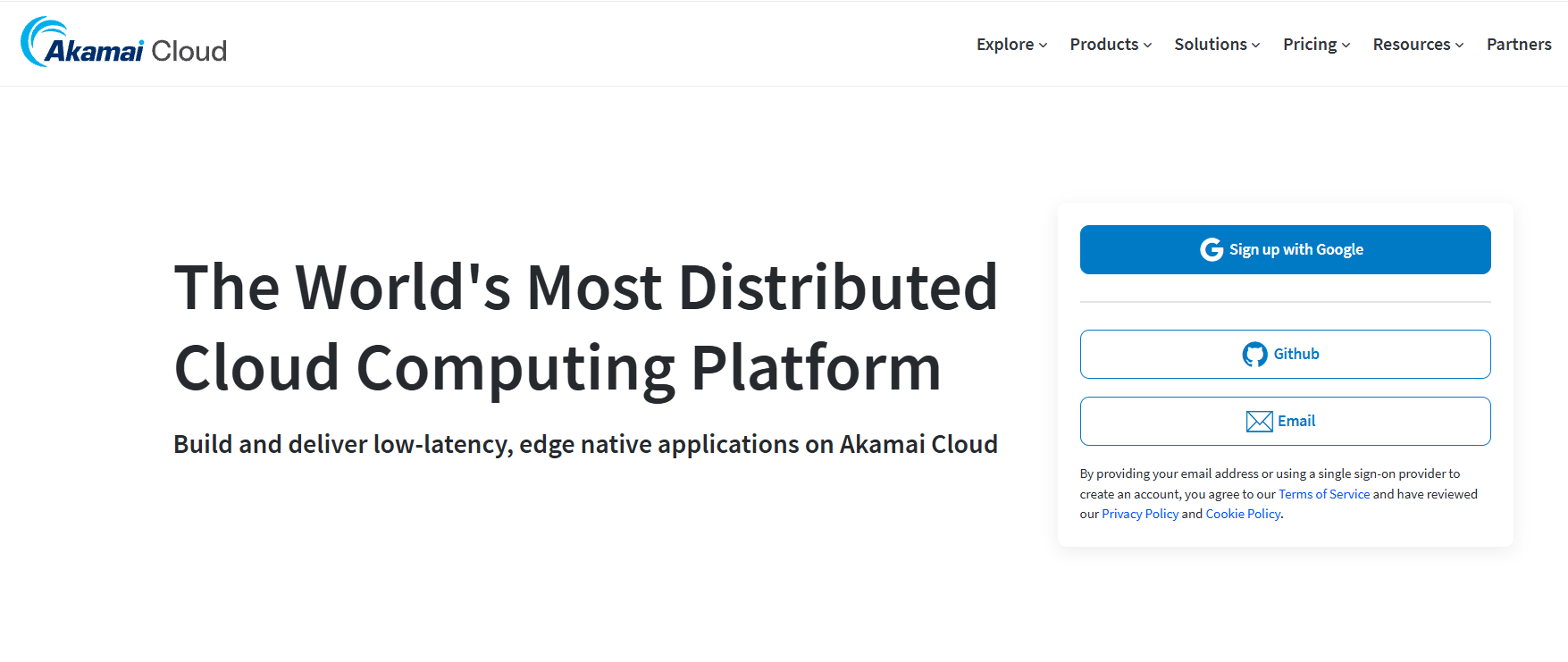 Linode, now part of Akamai, focuses on simple and affordable cloud infrastructure with a developer-first approach. It provides reliable compute and storage for small to mid-size workloads.
Linode, now part of Akamai, focuses on simple and affordable cloud infrastructure with a developer-first approach. It provides reliable compute and storage for small to mid-size workloads.
- Compute services: Standard and dedicated CPU instances for different performance tiers.
- Networking: Cloud Firewalls, load balancers, and private networking between instances.
- Kubernetes service: Managed Kubernetes engine for container-based workloads.
- Global reach: Data centers in key global locations for low-latency hosting.
- Best for: Developers needing predictable performance and budget-friendly infrastructure.
For developers evaluating similar platforms, check out Linode Alternatives to compare cost efficiency, scalability, and ease of deployment across modern providers like Kuberns.
10. Kamatera
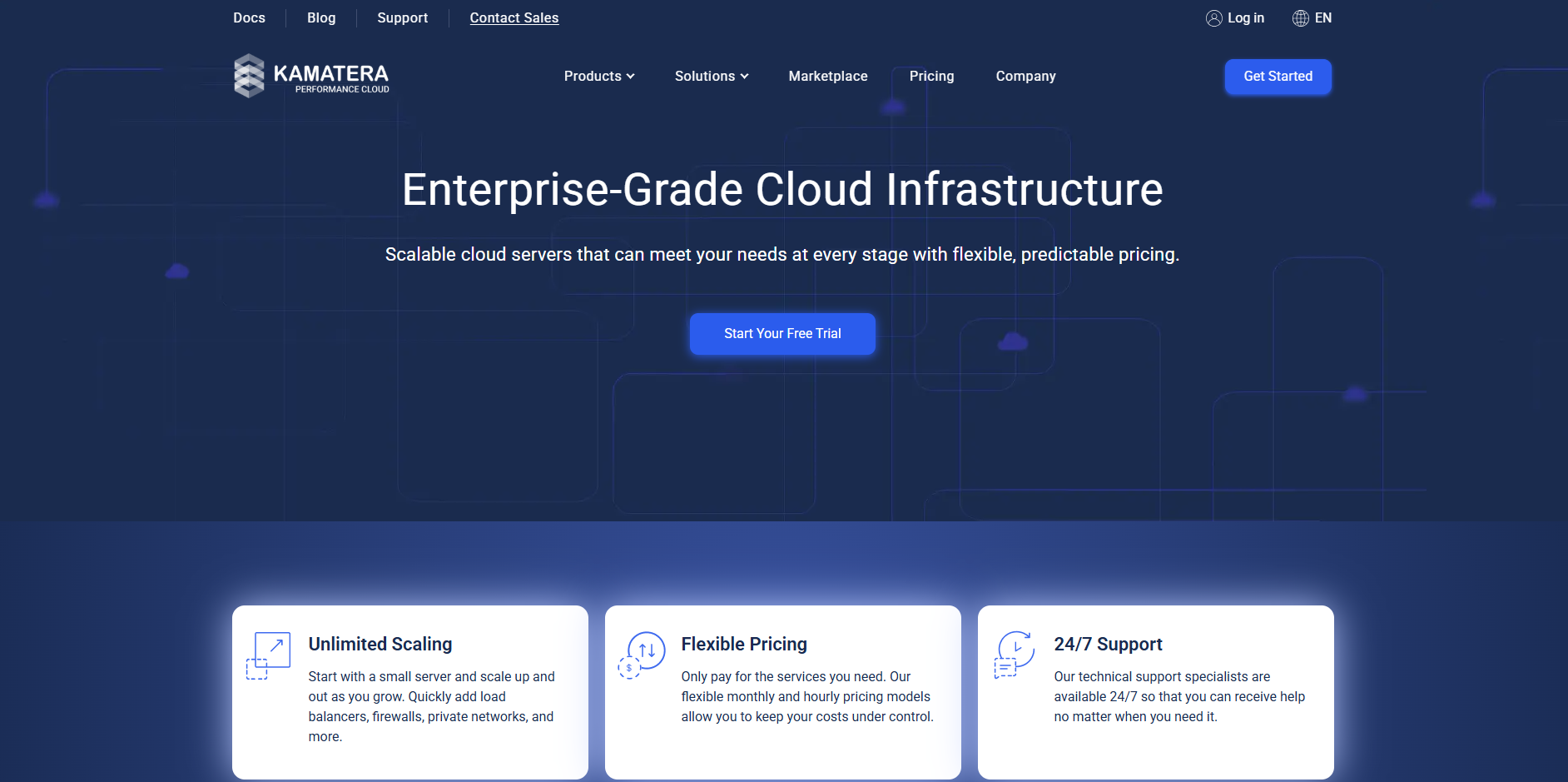 Kamatera provides a highly customizable cloud infrastructure with real-time resource adjustments. It’s known for flexibility and granular control over configurations.
Kamatera provides a highly customizable cloud infrastructure with real-time resource adjustments. It’s known for flexibility and granular control over configurations.
- Full customization: Users can adjust CPU, RAM, disk size, and network parameters anytime.
- Instant scaling: Servers can be added or modified within seconds through a simple dashboard.
- Data centers: Operates in multiple global locations across North America, Europe, and the Middle East.
- Support: 24/7 technical support and full root access to virtual servers.
- Best for: Developers or businesses requiring custom environments or variable workloads.
If you are comparing flexible hosting options, read Top Kamatera Alternatives for Your Cloud Needs to understand how Kuberns and other providers differ in performance, pricing, and automation.
How to Choose the Right IaaS Provider
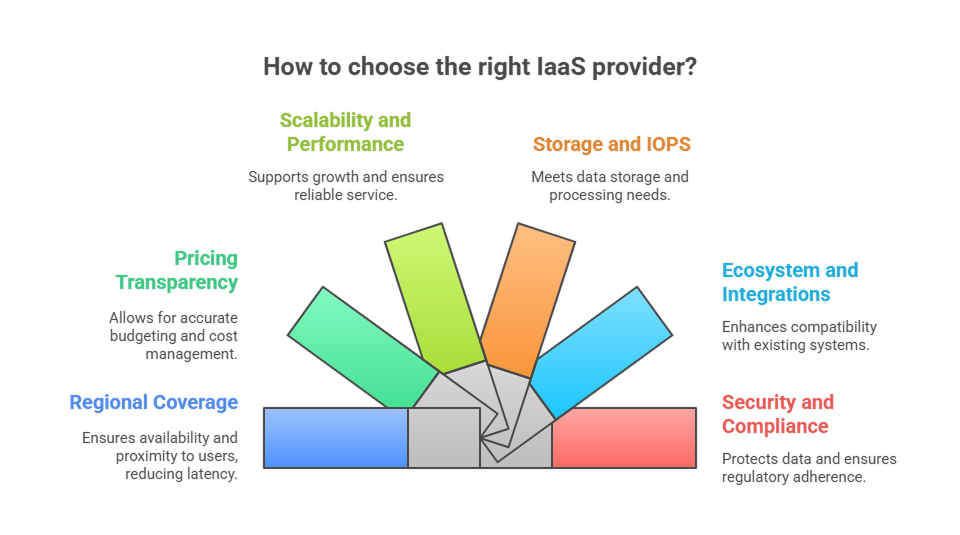 Choosing the right IaaS provider goes beyond comparing instance prices. It’s about finding a platform that aligns with your performance needs, scaling goals, and operational capabilities. Here are the key factors to consider before making your choice:
Choosing the right IaaS provider goes beyond comparing instance prices. It’s about finding a platform that aligns with your performance needs, scaling goals, and operational capabilities. Here are the key factors to consider before making your choice:
- Regional coverage: Select a provider with data centers close to your users to minimize latency and improve application responsiveness.
- Pricing transparency: Review all cost components, including compute, storage, and data transfer, to avoid unexpected expenses.
- Scalability and performance: Look for fast auto-scaling, reliable uptime, and efficient resource provisioning to handle traffic spikes smoothly.
- Storage and IOPS: Evaluate storage types, throughput, and IOPS limits for data-heavy workloads such as analytics or AI.
- Ecosystem and integrations: Ensure compatibility with tools for DevOps, CI/CD, machine learning, and observability.
- Security and compliance: Confirm the provider meets standards like ISO, SOC, or GDPR to maintain data integrity and trust.
If you want to simplify all of this from the start, Kuberns offers an intelligent automation layer on top of AWS infrastructure. It manages scaling, monitoring, and deployments automatically, helping you achieve high performance and cost efficiency without manual configuration.
Why Kuberns Is the Right Choice
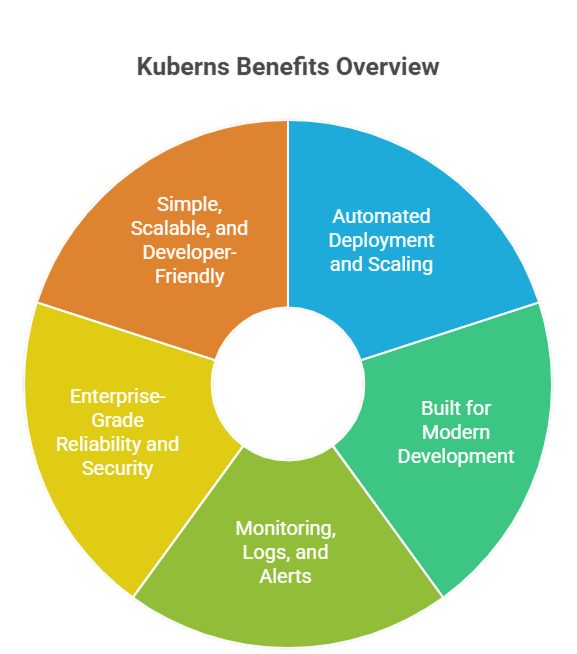 Most IaaS platforms provide great infrastructure but leave the heavy lifting of deployment, scaling, and monitoring to developers. Kuberns changes that. It combines the proven reliability of AWS infrastructure with intelligent automation that manages everything from provisioning to performance optimization. Teams can reduce infrastructure costs by up to 40% while maintaining speed, reliability, and scalability.
Most IaaS platforms provide great infrastructure but leave the heavy lifting of deployment, scaling, and monitoring to developers. Kuberns changes that. It combines the proven reliability of AWS infrastructure with intelligent automation that manages everything from provisioning to performance optimization. Teams can reduce infrastructure costs by up to 40% while maintaining speed, reliability, and scalability.
Kuberns is built for modern development workflows. It supports all major frameworks like Node.js, Python, React, and containerized microservices. Applications can be deployed directly from Git with a single click, and every deployment comes with integrated monitoring, live logs, and smart alerts. This gives developers complete visibility without additional setup or external tools.
Because Kuberns runs on AWS, it inherits the same enterprise-grade security, uptime, and compliance that global organizations trust, but with a simplified experience that removes DevOps complexity.
In essence, Kuberns combines the scalability of IaaS with the ease of PaaS. It empowers teams to deploy faster, scale automatically, and spend less, making it the smart choice for startups, agencies, and enterprises that want cloud performance without the overhead.
Conclusion
The cloud market is evolving fast, and automation is becoming the real differentiator. While AWS, Azure, and GCP dominate infrastructure, Kuberns adds an intelligent layer that simplifies everything.
By combining the reliability of AWS infrastructure with AI-driven deployment, Kuberns removes manual DevOps steps and reduces costs significantly. Whether you are launching your first app or managing complex microservices, Kuberns provides a one-click, stress-free deployment experience.
Start today at kuberns.com and see how you can save 40% on AWS infrastructure while deploying smarter.

Frequently Asked Questions (FAQ’s)
What is Infrastructure as a Service (IaaS)?
Infrastructure as a Service (IaaS) is a cloud computing model that delivers virtualized computing resources such as servers, storage, and networking over the internet. It allows businesses to rent infrastructure on demand instead of maintaining physical hardware.
Which are the top IaaS cloud providers in 2025?
The leading IaaS providers in 2025 include Kuberns, Amazon Web Services (AWS), Microsoft Azure, Google Cloud Platform (GCP), Alibaba Cloud, Oracle Cloud, IBM Cloud, DigitalOcean, Linode (Akamai), and Kamatera.
Why is Kuberns gaining attention among IaaS platforms?
Kuberns combines the reliability of AWS infrastructure with AI-powered automation for deployment, scaling, and monitoring. It helps teams cut AWS costs by up to 40% while simplifying cloud management through one-click deployment and built-in observability.
Which IaaS provider is best for startups and small businesses?
For startups, Kuberns and DigitalOcean are popular choices. Kuberns offers automation and cost efficiency for scaling teams, while DigitalOcean provides simple pricing and developer-friendly tools for smaller applications.
What is the difference between IaaS, PaaS, and SaaS?
- IaaS: Provides infrastructure resources like compute and storage.
- PaaS: Adds development and deployment tools on top of IaaS.
- SaaS: Offers complete applications accessed over the web. Kuberns bridges IaaS and PaaS by offering infrastructure with built-in automation.
Which IaaS provider is most cost-effective?
Kuberns is one of the most cost-effective options, offering up to 40% AWS savings with no platform or per-user fees. Other affordable choices include Linode and DigitalOcean, depending on workload type and region.
What are the key factors to consider when choosing an IaaS provider?
Evaluate regional availability, scalability, pricing transparency, performance, ecosystem integrations, and security. Platforms like Kuberns simplify this by automating scaling, monitoring, and deployment across AWS regions.
Which IaaS provider is best for enterprise workloads?
AWS, Microsoft Azure, and Oracle Cloud Infrastructure (OCI) are strong choices for enterprise environments due to their global reach, compliance standards, and advanced networking. Kuberns can also serve enterprise teams that prefer AWS with added automation.
Do IaaS providers support AI and machine learning workloads?
Yes. Providers like Google Cloud, AWS, and Azure offer AI and ML-specific services. Kuberns supports AI-based scaling and monitoring, making it suitable for deploying intelligent and data-driven applications efficiently.
How does Kuberns differ from traditional cloud platforms?
Unlike traditional IaaS platforms that require manual setup and DevOps management, Kuberns automates deployment, scaling, and monitoring. It gives developers a stress-free way to manage full-stack applications while maintaining control and visibility.